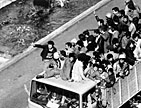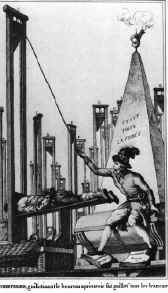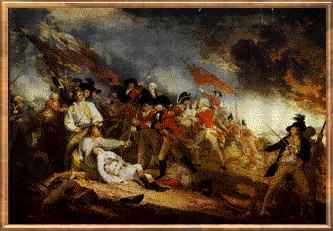LONG STORY SHORT
By L. Dean Webb
CHAPTER 3. REVOLUTIONS
Questions to Consider:
- What sort of changes are associated with revolutions?
- What is the key long-term cause of revolutions?
- Why does it require political organization to effect a revolution?
- Does middle-class unrest always result in revolution?
- What is the moderate phase?
- What is the radical phase?
- What is the thermidor phase?
A revolution is a period of time when people make incredible changes in government, society, technology, and/or religion. We're not talking about a few tinkering changes here and there. This is wholesale, across-the-board change. Those who promote the changes are revolutionaries and they can be moderate or radical in their approach to making changes. Those who are opposed to widespread changes are labeled reactionaries or counter-revolutionaries.
So what's the difference between a revolutionary and a reformer?
A revolutionary rejects the current way things are done as is willing to change it dramatically. A reformer accepts the current way things are done and will make changes only if they won't upset the established order.
Who's likely to be a revolutionary?
In a political context, it's someone who is excluded from decision making processes under the current regime. Those who make the decisions have no problem holding power.
 But more than it being a case of sour grapes, the revolutionaries want to actually change the status quo and create a new system for assigning power. That's what made the American Revolution a revolution and not a revolt. The colonies ditched monarchy in favor of a representative government. When coups replaced Iranian leaders, it was the same old same old. When Ayatollah Khomeini's followers set up an Islamic republic and cut ties with the USA, that was a revolution. The combination of railroads, steel, and assembly lines brought about industrial revolutions in countries able to put them together. Not all revolutions need be political, remember that. The political ones are just the bloodiest. With that in mind, I'm going to focus the rest of this on political revolution.
But more than it being a case of sour grapes, the revolutionaries want to actually change the status quo and create a new system for assigning power. That's what made the American Revolution a revolution and not a revolt. The colonies ditched monarchy in favor of a representative government. When coups replaced Iranian leaders, it was the same old same old. When Ayatollah Khomeini's followers set up an Islamic republic and cut ties with the USA, that was a revolution. The combination of railroads, steel, and assembly lines brought about industrial revolutions in countries able to put them together. Not all revolutions need be political, remember that. The political ones are just the bloodiest. With that in mind, I'm going to focus the rest of this on political revolution.
All political revolutions are rooted in middle-class frustrations. When elites are frustrated, they assassinate each other and then carry on as before. Or they buy each other off, start a power struggle, stage coups, whatever. You can't tell one faction from the other when this sort of thing happens, as nothing fundamental changes. When the peasants are frustrated, they rise up to smash the state and get massacred by the better-organized forces of the state. The only ones who make changes are the middle classes.
What causes the middle classes to start a revolution?
Given a long-term cause of frustrations, middle classes will just sit around and whine about things for a long time. But if there's a period of instability, they can organize to force action.
What causes instability?
Economic depressions, alienation of a popular movement, weakness or division in the elite, or a war can all open up instability in a country. A depression puts lots of people out of work and dashes the rising hopes of the middle classes. Alienation of popular religious or social movements can radicalize the movements to where they will not be content to effect a few changes, but will push them to demand sweeping changes. Weakness in the elite can be exploited by the middle class: it can eliminate some, most, or all of the ruling class and then move in to fill the power vaccuum. War is one of the most stressful of situations, and an unpopular war going on too long or a dramatic loss in war can both take a middle class over the edge into instability.
Although these situations take the middle classes to the brink of revolution, they do not themselves cause the revolution. One of these medium-term causes of instability requires a spark, a trigger, to set off the pent-up tensions and unleash the forces of revolution. Triggers would include a massacre of peaceful demonstrators, massive public demonstrations, actions against a popular leader or figurehead, severe losses in a war, or other dramatic moments in history such as those.
Keep in mind that even having middle class frustrations, instability, and a trigger does not guarantee a violent revolution will be the result. If the government itself can make major changes, then the revolution can proceed peacefully. The government will also have to do some amazing feats of public relations, but in today's mass media society, that is easier to do than in earlier times of history.
So how does a revolution go?
A revolution follows three main phases. The beginning, the middle, and the end.
Duh.
 But, in order to sound smarter, historians and political scientists have to give them different names. The different names are also to be a little more precise about what's going on. The beginning is the moderate phase, the middle is the radical phase, and the end is the terminal or thermidor phase.
But, in order to sound smarter, historians and political scientists have to give them different names. The different names are also to be a little more precise about what's going on. The beginning is the moderate phase, the middle is the radical phase, and the end is the terminal or thermidor phase.
Thermidor? What?
That's the name of the month of the French Revolutionary calendar in which Robespierre got executed. Robespierre was a radical. When he went to the guillotine, the radical phase of the French Revolution ended. While we don't use the French Revolutionary calendar anymore, we still call the end of a revolution the thermidor phase.
OK. So why do we need to differentiate phases of a revolution?
I didn't ask that.
You should have.
Oh.
Yeah. So, the beginning of a revolution is called a moderate phase because although sweeping changes are being made, the people in charge of the changes aren't trying to get rid of everything associated with l'ancien regime.
More French?
Yeah. It means "the old government." You won't see many people getting marched in front of firing squads during a moderate phase. Folks can still get roughed up and thrown into prison, but they also have a shot at fleeing the country in one piece.
Moderate policies run into trouble as crisis situations mount one on top of the other, creating a whole pile of difficulty. Foreign governments may be intervening to get regimes friendly to them in power, or threatening outright military conquest. Loyalists to the old government may be agitating for an end to the changes or actually plotting a violent return to power. Danger is everywhere and keeping a steady course of limited change is seen by more and more people within the revolution as a weakness. When people who believe changes should be eliminating more of l'ancien regime take power, the revolution enters its radical phase.
There's no rule to show how long a moderate or radical phase will last, just on how to recognize the transition periods.
In the radical phase, executions begin. Enemies of the state are labeled and hauled up before tribunals and killed. Loyalists are lynched by gleeful throngs of murderous revolutionaries. Traces of the old government are searched for and destroyed. The radicals tend to be very thorough in their terror and usually succeed in cementing some or most of the revolutionary changes. The radicals are usually able to stand against foreign enemies and weather their storms.
Once the greatest changes are made, things begin to settle. This is the thermidor phase. In this phase, some of the more extreme changes are rolled back and old ways return. Sometimes, the new regime becomes indistinguishable from the old. Granted, there may be some fundamental social differences, but the old abuses of power come back into play once those in power find loopholes in the revolution to allow their return.
Kinda like how the pigs turned into humans in Animal Farm?
Yep. But it's like that in nearly every revolution, not just the Russian. I think it's a disservice to claim Animal Farm is only about the Russian Revolution. I can see parallels to the French Revolution, the Nazi takeover of Germany, and even the American Revolution. Some revolutions have a better fit to the plot of the novel, but all have close similarities.
 OK, so explain this theory of revolutions with the American Revolution.
OK, so explain this theory of revolutions with the American Revolution.
Gladly.
The moderate phase began when the colonists organized their own local governments and agitated against taxes and a lack of political representation. The propertied classes led these movements, organized themselves, and basically controlled the countryside by 1775. British governors and military commanders remarked that they had little or no control of the colonists at the time. During 1775-1776, the American Revolution entered a radical phase. Seeing no other alternative, many Americans saw fit to sever all ties with their mother country and engage in an armed rebellion. The radical phase continued through to the end of the Confederation of States. The thermidor phase began with the strong federal government created under the 1787 Constitution. Central authority returned to the former colonies, albeit in a modified form.
One needs to realize America has had more than one political revolution since 1775, even though they have been fortunately unbloody ones. Revolutions tend to accompany changes in economic phases, from pre-industrial to industrial and from industrial to post-industrial. The most suceessful ones are those that manage to have a nonviolent or relatively nonviolent radical phase: with little or no blood shed, people are more likely to feel comfortable with the changes made in the radical phase.
The revolutions in Eastern Europe in 1989 are perfect examples, as is the revolution in South Africa at the same time. American social revolutions in the 1960's and 1970's are also excellent examples of long-lasting revolutions with limited rollback in the thermidor phase. Rather, the changes made will be around for generations.
LONG STORY SHORT